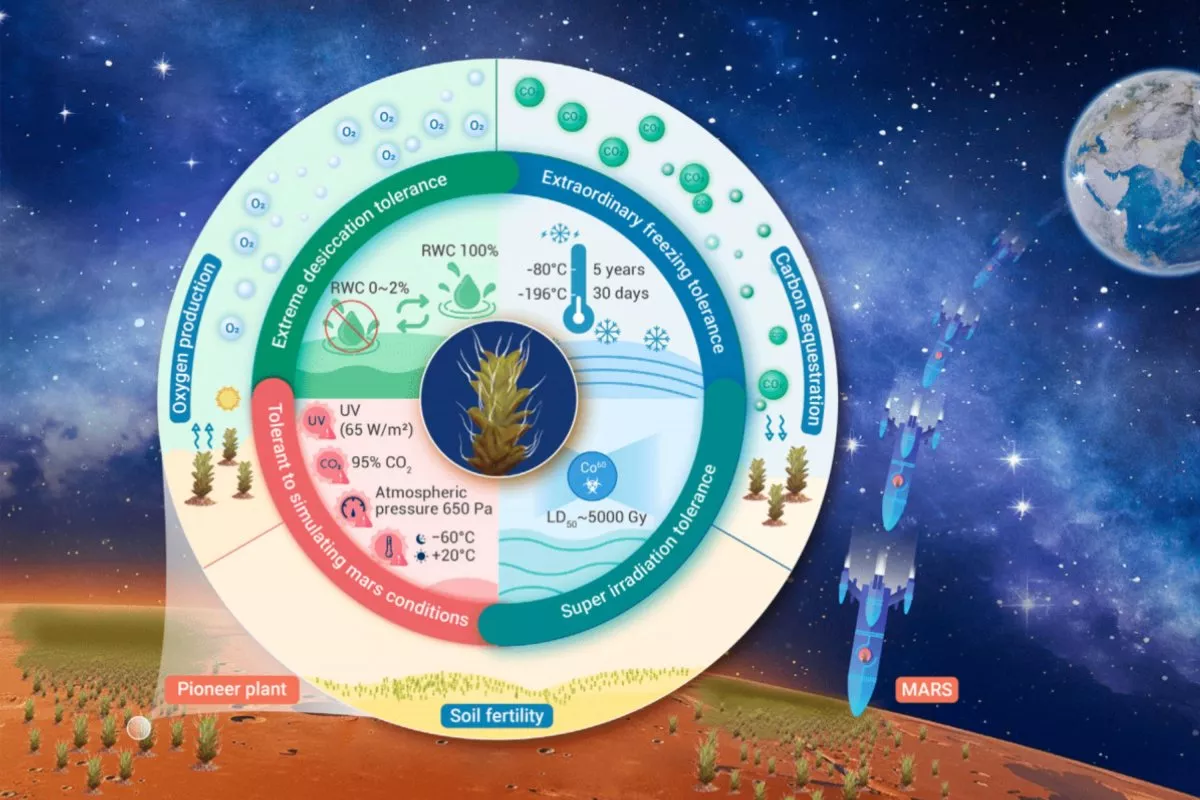A future civilization on Mars may be accompanied by a very special and resilient little plant.
A type of moss found in the desert – called Syntrichia caninervis— may be able to survive and grow in the harsh Martian environment, according to a new paper in the journal INNOVATION.
This moss can grow in temperatures as cold as -320.8 degrees Fahrenheit and can survive levels of gamma radiation that would kill most other plants and life forms.
The plant can also withstand extremely dry conditions, as well as a combination of drought, heavy radiation and cold weather in a simulation of conditions on the Red Planet.
“Our study shows that environmental resilience i S. caninervis is higher than that of some highly stress-tolerant microorganisms and tardigrades,” the researchers wrote in the paper.S. caninervis is a promising candidate pioneer plant for the colonization of extraterrestrial environments, laying the foundations for the construction of biologically sustainable human habitats beyond Earth.”

ISTOCK / GETTY IMAGES PLUS / Innovation, Li et al. 2024
Mars has a variety of conditions that make it challenging for human exploration and possible habitation, with a thin atmosphere composed mostly of carbon dioxide, with small amounts of nitrogen, argon, and trace amounts of oxygen and water vapor. Atmospheric pressure on Mars is less than 1 percent of Earth’s, averaging about 6 millibars, compared to Earth’s 1,013 millibars at sea level, and the average surface temperature is about -80 degrees F, but can range from about -195 degrees F during the winter. at the poles to 70 degrees F during summer at the equator.
Furthermore, water on Mars exists mostly as ice, with the polar ice caps composed of water and dry ice (frozen carbon dioxide). Mars also does not have a global magnetic field like Earth, meaning that everything on its surface is exposed to high levels of cosmic radiation that would pose a significant risk to human explorers and anything that grows on Earth. his.
This is the first time an entire plant has been tested for its ability to withstand conditions in space or on another world. Syntrichia caninervis it is found all over the world growing in harsh environments ranging from Tibet to Antarctica, making it the perfect candidate for testing in Martian conditions.
In the paper, the researchers describe how moss was stored at -112 degrees F for three or five years, and at -320 degrees F for 15 and 30 days. After the thaw, they found that the plants were able to regenerate and grow. They also found that if the moss was dehydrated before freezing, they healed faster.

Innovation, Li et al. 2024
They also tested the plant under different doses of radiation, finding that it survived and even thrived at levels up to 500 Gray (Gy)—humans, by comparison, typically die after exposure to about 8 Gy.
“Our results show this S. caninervis is among the most radiation-tolerant organisms known,” the researchers wrote in the paper.
The researchers then combined all these Martian environmental factors, exposing the plant to temperatures fluctuating between -76 and 68 degrees F, low atmospheric pressure, air consisting of 95 percent CO2, and high levels of ultraviolet radiation. They found that if the moss was previously dried, it had a 100 percent recovery rate 30 days after exposure, while hydrated plants also recovered, but much more slowly.
“S. caninervis represents a promising candidate as a colonist to ease the terrain
forming efforts on Mars or other planets. This is not only because S. caninervis
is a land plant with extreme tolerance to multiple stress but also because it can
serve as pioneer species and basis for creation and maintenance
of the ecosystem by contributing to oxygen production, carbon sequestration,
and soil fertility,” the researchers write. “Thus, S. caninervis may help drive the atmospheric, geological, and ecological processes required for plants and other higher animals, facilitating the creation of new favorable habitable environments for the long-term settlement of people.”
They continued: “Although there is still a long way to go to create self-sustaining habitats on other planets, we demonstrated the great potential of S. caninervis as a pioneer plant for growth on Mars. Looking to the future, we expect this promising moss to be brought to Mars or the Moon to further test the possibility of colonizing and growing plants in outer space.”
Do you have a tip for a science story that Newsweek should be covered? Have a question for Mars? Tell us via science@newsweek.com.
Unusual knowledge
Newsweek is dedicated to challenging conventional wisdom and finding connections in search of common ground.
Newsweek is dedicated to challenging conventional wisdom and finding connections in search of common ground.